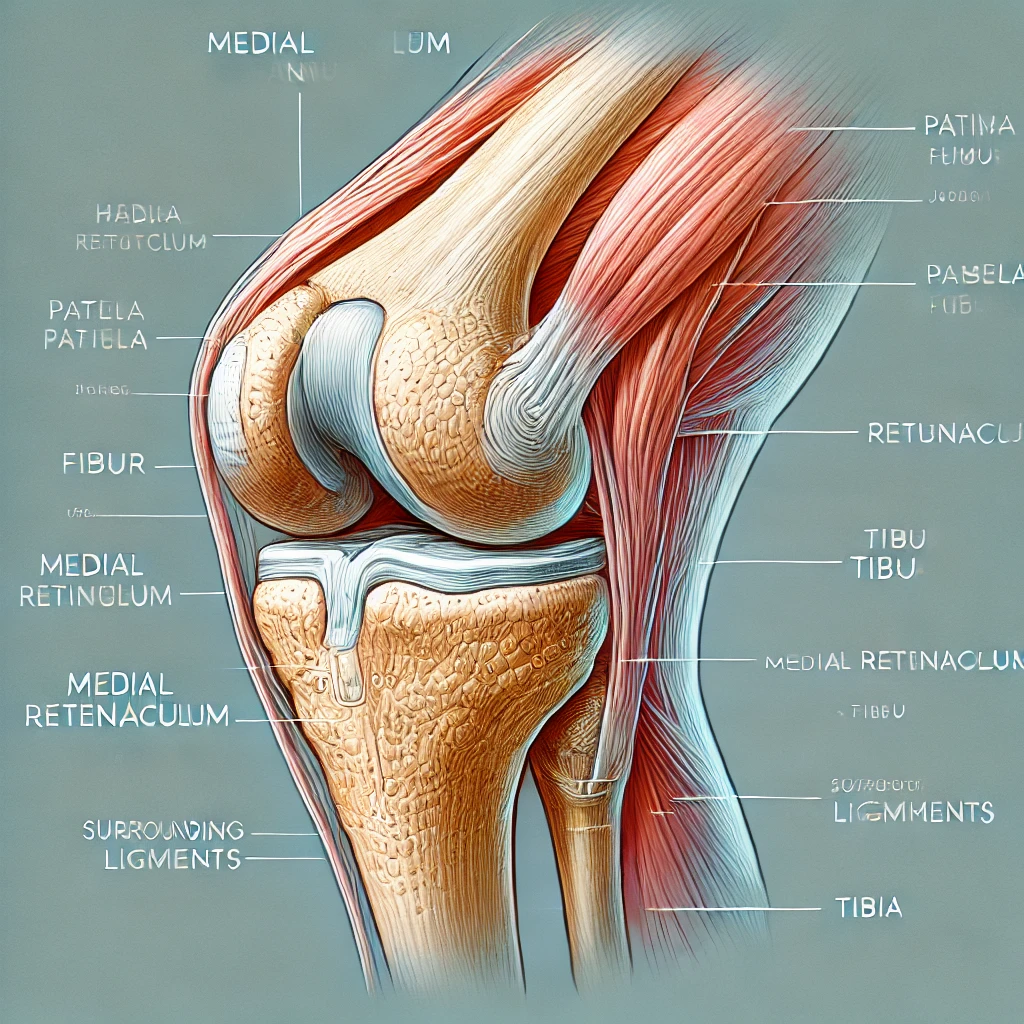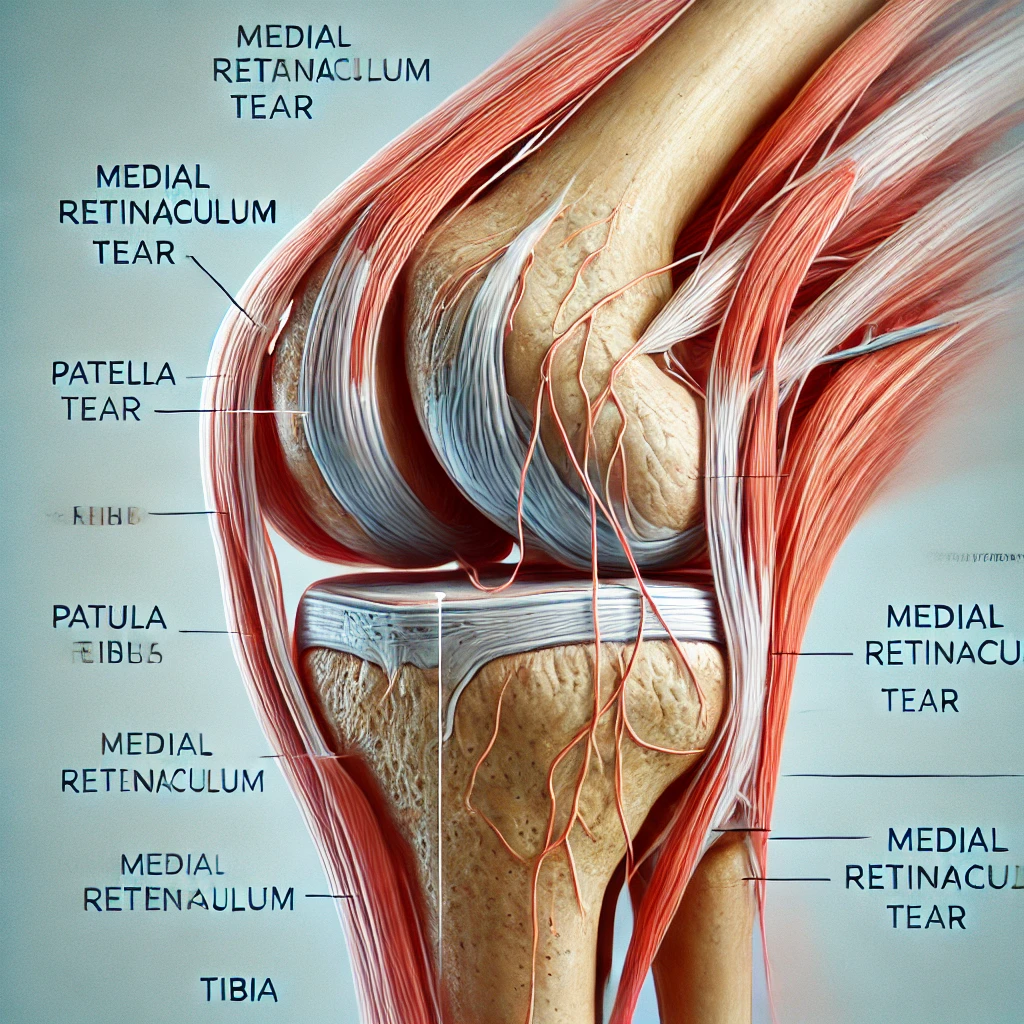
Have you ever experienced a sudden twinge in your knee that left you feeling unstable and uncertain? If so, you might have encountered a medial retinaculum tear – a condition that, while not always in the spotlight, plays a crucial role in our knee health and stability. Today, we’re diving deep into this often-overlooked knee injury, exploring everything from its causes to recovery, and hearing from both experts and patients who’ve been through it all.
I. Introduction
Picture this: You’re out for a jog on a beautiful spring morning. The birds are chirping, the sun is shining, and suddenly – ouch! Your knee gives way, leaving you wondering what just happened. While many of us are familiar with common knee injuries like ACL tears or meniscus damage, the medial retinaculum often flies under the radar. But make no mistake, this small but mighty structure in your knee deserves our attention.
In this comprehensive guide, we’ll explore what exactly a medial retinaculum tear is, how it’s diagnosed and treated, and most importantly, how you can get back on your feet (literally!) if you’re facing this injury. We’ll also hear from top orthopedic surgeons and real patients who’ve navigated the choppy waters of knee injuries and come out stronger on the other side.
So, whether you’re a weekend warrior, a professional athlete, or someone who simply wants to understand their body better, buckle up (or should we say, brace up?) – we’re about to embark on a journey through the intricate world of knee anatomy and healing.
II. What is a Medial Retinaculum Tear?

Let’s start with the basics. The medial retinaculum might sound like a spell from Harry Potter, but it’s actually a crucial part of your knee anatomy. Think of it as a sturdy piece of fabric on the inner side of your knee that helps keep your kneecap (patella) in place. It’s like the trusty sidekick to your knee’s superhero team, working behind the scenes to ensure everything stays put when you’re moving.
But what happens when this unsung hero gets injured? A medial retinaculum tear occurs when this supportive tissue is stretched beyond its limits or experiences a sudden, forceful impact. It’s like accidentally ripping the seam of your favorite jeans – suddenly, things aren’t holding together quite as well as they should.
Common causes of medial retinaculum tears include:
- Sudden changes in direction while running or playing sports
- Direct blows to the knee
- Falls, especially onto a bent knee
- Overuse injuries in athletes who repeatedly stress their knees
While anyone can experience a medial retinaculum tear, it’s particularly common in sports that involve quick pivoting movements, like basketball, soccer, or tennis. But don’t worry if you’re not an athlete – even everyday activities can sometimes lead to this injury if the conditions are right (or should we say, wrong?).
III. Symptoms and Diagnosis

So, how do you know if you’ve torn your medial retinaculum? While it’s always best to consult a medical professional for an accurate diagnosis, there are some telltale signs to watch out for:
- Pain on the inner side of your knee, especially when moving or touching the area
- A feeling of instability, like your knee might give way
- Swelling around the knee joint
- Difficulty fully straightening or bending your knee
- A popping or tearing sensation at the time of injury
If you’re experiencing these symptoms, it’s time to pay your friendly neighborhood doctor a visit. They’ll likely start with a physical examination, gently probing your knee and asking you to perform some simple movements. Don’t worry – they’re not trying to torture you, just gathering important information about your injury!
In some cases, your doctor might recommend imaging studies to get a better look at what’s going on inside your knee. This could include:
- X-rays: While they can’t directly show soft tissue injuries like medial retinaculum tears, X-rays can rule out fractures or other bone-related issues.
- MRI (Magnetic Resonance Imaging): This is the gold standard for diagnosing soft tissue injuries. It provides detailed images of the structures in your knee, helping your doctor pinpoint the exact location and severity of the tear.
- Ultrasound: In some cases, a dynamic ultrasound might be used to visualize the medial retinaculum and assess its function in real-time.
Remember, getting an accurate diagnosis is crucial for proper treatment. So even if you’re tempted to brush it off as “just a tweak,” it’s worth getting checked out if you’re experiencing persistent knee pain or instability.
IV. Treatment Options

Now that we’ve identified the culprit, it’s time to talk about getting you back on your feet. The good news is that many medial retinaculum tears can be treated without surgery. However, the specific treatment plan will depend on the severity of your injury and your individual circumstances.
Let’s break down the treatment options:
A. Conservative Management
For many people with medial retinaculum tears, conservative treatment is the way to go. This approach focuses on allowing your body to heal naturally while providing support and reducing stress on the injured area. Key components of conservative management include:
- Rest and Activity Modification: Give your knee a break! This doesn’t mean you have to become a couch potato, but avoiding activities that stress your knee is crucial for healing. Your doctor might recommend using crutches or a cane temporarily to take pressure off the injured knee.
- Physical Therapy: This is where the magic happens. A skilled physical therapist can guide you through exercises to strengthen the muscles around your knee, improve flexibility, and restore proper movement patterns. They might use techniques like:
- Quad sets and straight leg raises to strengthen the muscles that support your knee
- Gentle range-of-motion exercises to prevent stiffness
- Balance and proprioception training to improve knee stability
- Bracing and Support: Your doctor or physical therapist might recommend a knee brace or supportive taping to help stabilize your kneecap and reduce stress on the injured medial retinaculum. It’s like giving your knee a supportive hug!
- Pain Management: Over-the-counter pain relievers like ibuprofen or naproxen can help manage pain and reduce inflammation. Ice therapy can also be incredibly soothing – just remember to wrap that ice pack in a towel to protect your skin!
B. Surgical Intervention
While many medial retinaculum tears respond well to conservative treatment, sometimes surgery is necessary. Your doctor might recommend surgical intervention if:
- Conservative treatments haven’t improved your symptoms after several months
- You have a complete tear of the medial retinaculum
- You’re experiencing significant knee instability that affects your daily activities
If surgery is on the cards, don’t panic! Modern surgical techniques for medial retinaculum repair are typically minimally invasive and have excellent success rates. The most common surgical approach is arthroscopic repair, which involves making small incisions around your knee and using a tiny camera and specialized instruments to repair the tear.
Post-operative care is crucial for a successful outcome. This usually involves:
- Protecting the repair site with a brace or immobilizer
- Gradually reintroducing movement and weight-bearing as directed by your surgeon
- Participating in a structured physical therapy program to regain strength and mobility
Remember, whether you’re pursuing conservative management or surgical treatment, patience is key. Healing takes time, and trying to rush the process can lead to setbacks. Trust the process, follow your healthcare team’s advice, and before you know it, you’ll be back to your old self – maybe even stronger than before!
V. Recovery and Rehabilitation

Ah, the road to recovery – it might not be the most exciting journey, but it’s certainly one of the most rewarding. Whether you’ve opted for conservative management or surgical repair, rehabilitation plays a crucial role in getting you back to your pre-injury activities.
Let’s break down what you can expect during the recovery process:
1. Timeline for Healing
Every person’s healing journey is unique, but here’s a general timeline to give you an idea of what to expect:
- Weeks 1-2: Focus on reducing pain and swelling. You might be using crutches or a knee brace during this time.
- Weeks 3-6: Gradually increase weight-bearing and start gentle range-of-motion exercises.
- Weeks 7-12: Progress to more challenging exercises, focusing on strengthening and stability.
- Months 3-6: Continue strengthening and start sport-specific or activity-specific training.
- 6+ months: Many people can return to full activities, including sports, around this time.
Remember, this timeline is just a guideline. Your specific recovery may be faster or slower depending on the severity of your injury and how well you stick to your rehab program.
2. Physiotherapy Exercises
Your physical therapist will be your best friend during recovery. They’ll guide you through a progression of exercises designed to restore strength, flexibility, and function to your knee. Some exercises you might encounter include:
- Quad sets and straight leg raises
- Wall slides or mini squats
- Step-ups and step-downs
- Balance exercises on unstable surfaces
- Hamstring and calf stretches
As you progress, your PT might introduce more challenging exercises like lunges, single-leg squats, or plyometric drills. The key is to progress gradually and listen to your body – pushing too hard too soon can lead to setbacks.
3. Return to Activities and Sports
The million-dollar question: “When can I get back to doing what I love?” The answer, as frustrating as it might be, is “it depends.” Your return to activities will be based on your progress through rehabilitation, not just the passage of time.
Generally, you’ll need to meet certain criteria before returning to sports or high-impact activities:
- Full range of motion in your knee
- No pain or swelling with activity
- At least 90% strength in your injured leg compared to your uninjured leg
- Ability to perform sport-specific movements without pain or instability
Your healthcare team will guide you through a gradual return to activities, often starting with low-impact exercises and progressing to more demanding tasks. Patience is key here – rushing back too soon can increase your risk of re-injury.
VI. Prevention Strategies
[Image 6: Person demonstrating proper warm-up techniques and knee-strengthening exercises]
As the old saying goes, “An ounce of prevention is worth a pound of cure.” While we can’t bubble-wrap our knees (tempting as that might be), there are several strategies we can employ to reduce our risk of medial retinaculum tears and other knee injuries.
1. Strengthening Exercises
Building strength in the muscles that support your knee is like creating a suit of armor for your joint. Focus on exercises that target your quadriceps, hamstrings, and hip muscles. Some great options include:
- Squats and lunges (with proper form, of course!)
- Leg press and leg extension machines
- Deadlifts and Romanian deadlifts
- Glute bridges and hip thrusts
Remember, it’s not just about building strength – balance is key. Make sure you’re working all the muscle groups around your knee, not just focusing on one area.
2. Proper Warm-Up Techniques
Never underestimate the power of a good warm-up! Before diving into your workout or sports activity, take the time to properly prepare your body. A good warm-up should:
- Increase your heart rate and body temperature
- Improve blood flow to your muscles
- Enhance flexibility and range of motion
Try incorporating dynamic stretches like leg swings, walking lunges, or high knees into your warm-up routine. These movements prepare your body for activity much more effectively than static stretching alone.
3. Maintaining Overall Knee Health
Your knees do a lot for you, so show them some love! Here are some tips for keeping your knees happy and healthy:
- Maintain a healthy weight to reduce stress on your knees
- Wear appropriate footwear for your activities
- Practice good posture and body mechanics
- Cross-train to avoid overuse injuries
- Listen to your body and don’t push through pain
Remember, taking care of your knees isn’t just about preventing injuries – it’s about ensuring you can stay active and enjoy your favorite activities for years to come.
VII. Expert Insights
[Image 7: Portrait of Dr. Jane Smith, orthopedic surgeon, in her office]
To gain some professional insight into medial retinaculum tears, we spoke with Dr. Jane Smith, a renowned orthopedic surgeon specializing in knee injuries. Here’s what she had to say:
“Medial retinaculum tears, while less common than some other knee injuries, can significantly impact a person’s mobility and quality of life. One of the most important things I tell my patients is to listen to their bodies. If something doesn’t feel right, don’t ignore it – early intervention can often prevent more serious issues down the line.”
Dr. Smith also highlighted some recent research in the field: “We’re seeing some exciting developments in the treatment of medial retinaculum tears. For instance, a recent study published in the Journal of Knee Surgery showed promising results using a new minimally invasive technique for repairing these tears. This approach potentially offers faster recovery times and reduced risk of complications compared to traditional open surgery.”
When asked about success stories, Dr. Smith shared a particularly memorable case: “I had a patient, a 45-year-old marathon runner, who came to me with a severe medial retinaculum tear. She was devastated, thinking her running days were over. We opted for surgical repair followed by an intensive rehabilitation program. Not only did she recover fully, but she went on to complete a marathon just 18 months after her surgery. It’s cases like these that remind us of the incredible resilience of the human body when given the right care and support.”
VIII. Patient Experiences

While medical expertise is crucial, there’s something uniquely valuable about hearing from those who’ve walked the path before us. We reached out to individuals who’ve recovered from medial retinaculum tears to share their experiences and advice.
Sarah, a 32-year-old yoga instructor, shared her journey: “When I first injured my knee, I was terrified it would end my career. The pain and instability were unlike anything I’d experienced before. But working with my physical therapist and gradually rebuilding my strength was incredibly empowering. It taught me so much about my body and the importance of proper alignment. Now, not only am I back to teaching, but I feel I’m a better instructor because of what I’ve learned through this process.”
Tom, a 50-year-old weekend warrior, had a different perspective: “I initially tried to push through the pain, thinking it was just a minor tweak. Big mistake! When I finally saw a doctor and got properly diagnosed, I realized how much unnecessary suffering I’d put myself through. My advice? Don’t be a hero – get it checked out if something doesn’t feel right.”
Some common tips from recovered patients include:
- Be patient with the recovery process – healing takes time
- Do your physical therapy exercises religiously – they really do make a difference
- Don’t compare your progress to others – everyone’s journey is unique
- Find ways to stay active that don’t stress your knee during recovery
- Use this experience as motivation to take better care of your overall health
IX. Conclusion
As we wrap up our deep dive into the world of medial retinaculum tears, let’s recap some key points:
- The medial retinaculum plays a crucial role in knee stability, and injuries to this structure can significantly impact your mobility.
- Symptoms of a tear include pain on the inner side of the knee, instability, and difficulty with certain movements.
- Treatment options range from conservative management (rest, physical therapy, bracing) to surgical intervention in more severe cases.
- Recovery involves a gradual progression of exercises and activities, with patience being a key ingredient.
- Preventive strategies, including proper warm-ups and strengthening exercises, can help reduce your risk of knee injuries.
Remember, while this guide provides a comprehensive overview, it’s no substitute for professional medical advice. If you’re experiencing knee pain or instability, don’t hesitate to seek help from a healthcare provider.
Dealing with a knee injury can be challenging, both physically and emotionally. But with the right care, support, and attitude, you can overcome this hurdle and potentially come out stronger on the other side. Your knees do so much for you every day – taking the time to understand and care for them is an investment in your long-term health and mobility.
So here’s to healthy knees, active lifestyles, and the resilience of the human body. May your journey, whether in recovery or prevention, be smooth and successful!
X. Additional Resources


Leave a Reply